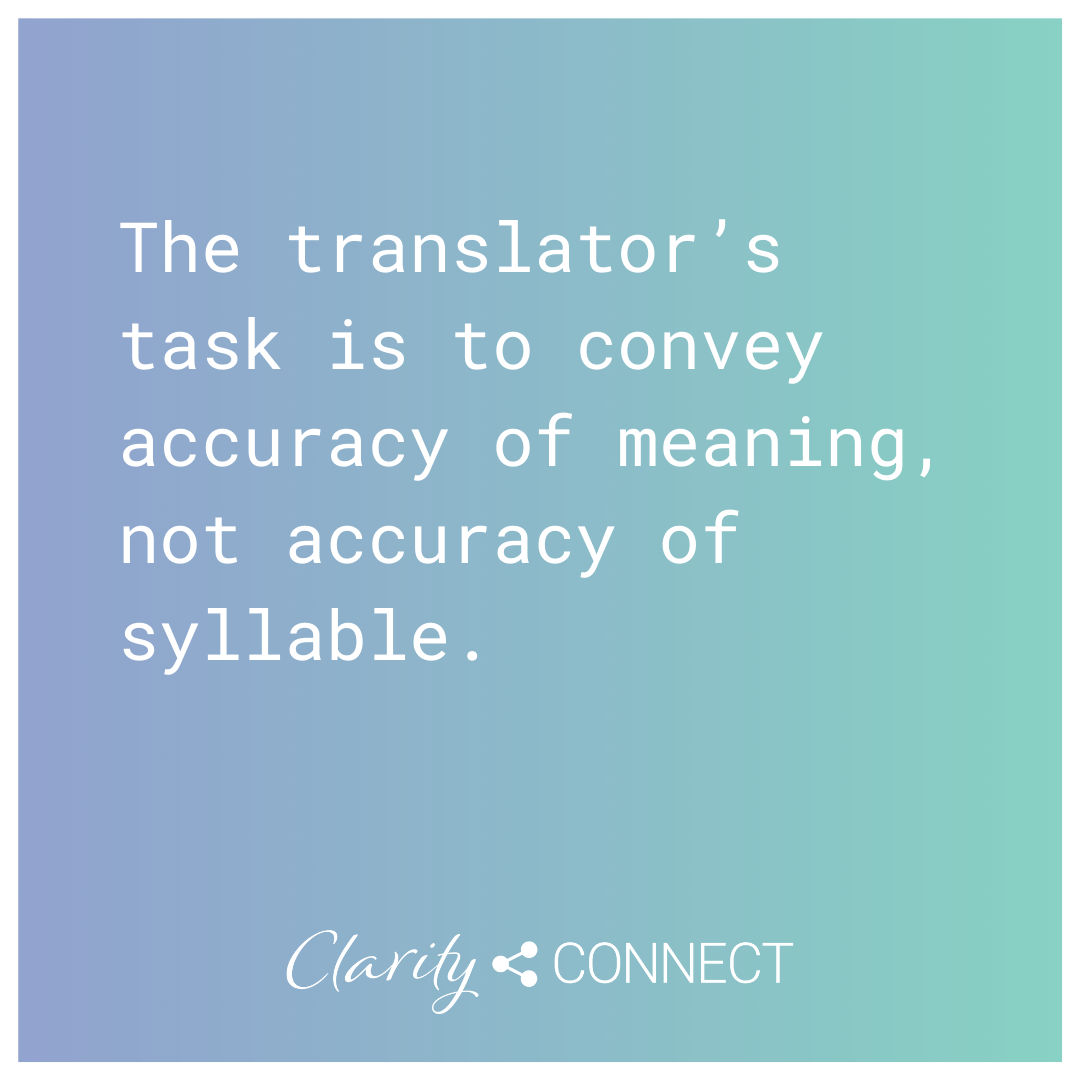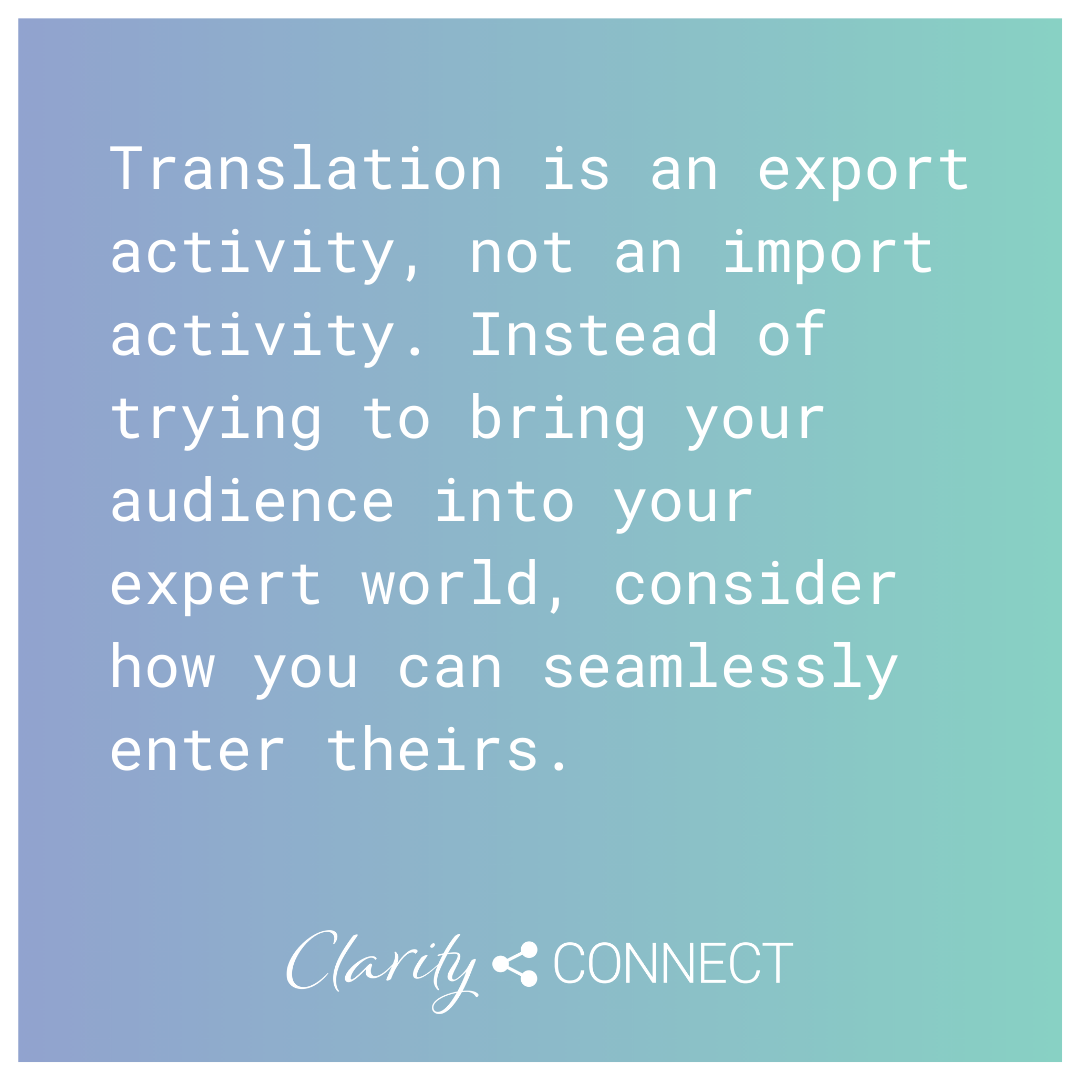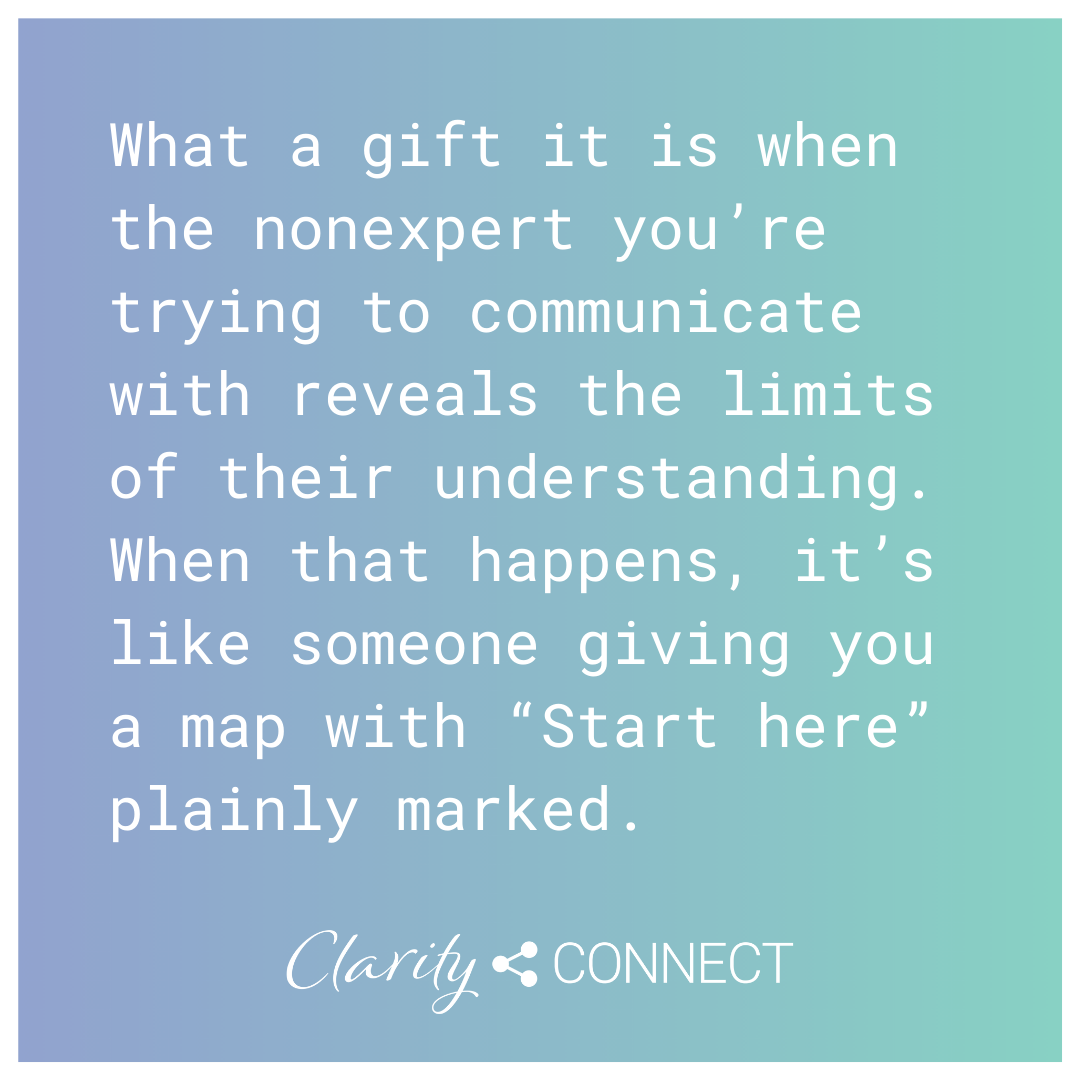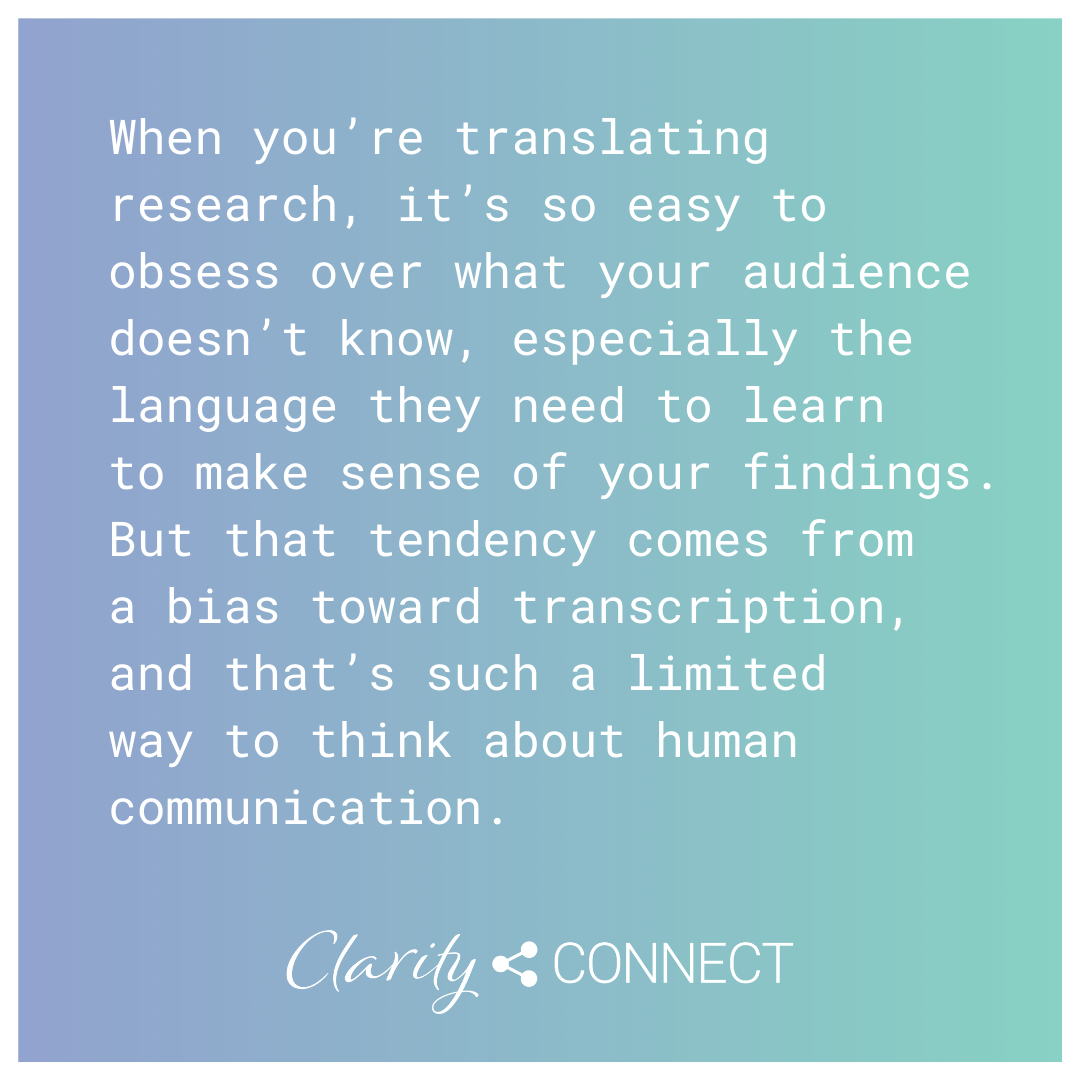
Try translating your meaning instead of transcribing it
Many client conversations start with a complaint about some aspect of the writing process. I hear statements like these:
“I just can’t seem to find the right words.”
“My grammar is terrible.”
“I want to know how to express myself more concisely.”
On the surface, such statements can seem to point to mechanical issues:
- Fumbling for the right words could indicate a usage issue (problem with accurately using vocabulary).
- Feeling ashamed about “grammar” could indicate an issue with structuring and punctuating sentences.
- Frustration with wordiness could indicate a lack of editing skill.
However, for many people I’ve had the privilege to teach or coach, the real problem is not a concern with the “how to” of writing. Their vexation stems from a larger issue: the challenge of translating expert knowledge into language and sentences that will engage their audience.
In academic and healthcare circles, researchers and communication specialists have established a name (and various methodologies and frameworks) for this difficulty. They call it knowledge translation or knowledge mobilization.[1] At Clarity Connect, we simply refer to it as research translation.
Associating communication challenges with research translation rather than with a lack of writing skill changes the questions one asks and the range of solutions available.
The chief concern is no longer “How can I correct my writing faults?” It’s “How can I get to know my audience better?”
This is good news because you can get better at research translation by drawing on your human skills. You don’t have to learn new software or figure out how to integrate yet another “tool” into the applications you use to craft documents, presentations, and social posts.
Translation is NOT transcription
When the writing process feels awkward, it’s easy to attribute the sense of clumsiness to a lack of technical skill. Because we now live in a world in which AI grooms and generates text, [2] we tend to assume that any glitches in human-produced writing must occur due to a flaw in the human algorithm.
That might be true in certain communication situations. For example, if spelling or syntax (word order) issues showed up in a form to order office supplies, then I would investigate the writer’s basic competencies.
In a context that requires little analysis or creative thought, mechanical issues can be exactly what they appear to be. Deficits in basic skills make it hard for writers to choose words and form sentences in ways that clearly convey their intended meaning, even when that meaning is not complex. Unskilled writers find it difficult to transcribe any of their thoughts into print.
But if you’re a highly educated professional trying to communicate complex ideas and information, then it’s highly unlikely that you have a transcription problem. You already have advanced writing skills, or you wouldn’t have been able to complete your education. Nor would you be able to produce the particular forms of written communication your career has demanded, such as technical reports, articles, and presentations.
Your problem is translating your ideas, not merely transcribing them. And translation, despite AI advances in this area, is more an art than a science.
Translation favors meaning over exactitude
My first degree was a joint BA in French and English, so I have some personal experience with the translation process. I can still feel how my heart raced and my palms sweated as I crouched over the desk in the audio booth where I had to record assignments for my class in traduction simultanée (simultaneous translation).
As the English voice came through the headphones, I struggled to convert them, instantaneously, into French sentences. The level of concentration the task required was extreme. At the end of each session, I felt as if I’d run a marathon while taking an oral Mensa exam.
Looking back, I found translation exercises so daunting because I was approaching them with a word-for-word mentality. Rather than focusing on the meaning I wanted to convey, I struggled to transcribe each English word or phrase I heard into a French word or phrase.
This wasn’t just incredibly inefficient. It was utterly wrongheaded. A more experienced translator wouldn’t have worried about translating each word. They would have focused on capturing the essence of each sentence through authentic, fluid expression.
As a researcher or technical expert, whenever you’re communicating with an audience outside your peer group, your task is to convey essential meaning. Translate for gist rather than grammar—so that your communication sounds genuine and resonates with your intended audience.
Yes, accuracy is important. Indeed, I shudder every time someone talks about “dumbing down” a complex concept or data set. But the translator’s task is to convey accuracy of meaning, not accuracy of syllable.

Audience knowledge is communication power
When you view writing challenges as research translation challenges, then you look for different kinds of solutions. Instead of focusing on editing-level issues (such as jargon and bulky sentences), you start asking questions about the people for whom you’re translating your knowledge.
The “who” of writing becomes more important than the “how.” Rather than fretting over your document structure and style, you invest time in getting to know your audience. The more you know about them, the easier it will be for you to connect with them through their language.

Translation is an export activity, not an import activity. Instead of trying to bring your audience into your expert world, consider how you can seamlessly enter theirs. Research your audience with as much passion as you’d spend digging up background on a technical topic. Find out answers to such questions as these:
- What do they care about?
- What keeps them up at night?
- What words and phrases (accurate or not) do they use to discuss the topic you’re addressing?
- How do they feel when they think about the topic?
- What metaphors do they gravitate to when they try to restate complex concepts in their own language?
- What myths about the topic do they believe?
- Why is it worth their while to learn about the topic?
For translators, vocabulary is power. Make it your mission to learn the language your audience speaks, even if some of the generalizations or scientific inaccuracies make you wince. The more familiar you become with your audience’s dialect, the easier it will be for you to capture the meaning you want to express in language that sounds familiar and gets heard.
Only once you’ve connected with your audience using their language can you start to educate them on how to use your specialized terminology.
A lesson on finding your “connection point”
To illustrate what it means to start with your audience’s language, not your own, let me share with you a story I heard more than 15 years ago from a senior manager in a global consulting firm. We’ll call him Raj.
When Raj joined the technical communication course I was leading, he and his team had just finished implementing an Enterprise Resource Planning (ERP) system across a large corporation. An ERP is an all-encompassing system that contains all the software an organization needs to run its organization. (If you’ve ever used SAP or Oracle, than you have first-hand experience with an ERP.) For more than a year, Raj and his colleagues had been planning, installing, and customizing software to cover everything from accounting to customer management to inventory management and more.
At the end of the project, the CEO of the corporation, who had not been involved in the day-to-day activities, said to Raj, “So… I hear you’ve gotten us a new computer.”
A less-experienced consultant would have tried to argue with the CEO and explain the difference between a suite of customized, interconnected ERP “modules” and the hardware needed to run them. But Raj took it in stride and adapted accordingly. If the CEO understood a complex computer system as a “computer,” then he would have to start there.

Raj smiled as he shared this story with me and the rest of the participants in the communication course. Through years of experience, he’d learned to bring a sense of humor to his work of translating technical concepts into business-speak. He’d also learned what a gift it is when the nonexpert you’re trying to communicate with reveals the limits of their understanding. When that happens, it’s like someone giving you a map with “Start here” plainly marked.
In this case, the CEO had shown that he knew what a computer was, but he clearly didn’t comprehend that a computer consists of hardware and software. Nor had he grasped the concept of all the company’s computers being networked so they could share the same software and a single database.
To help the CEO understand and appreciate the wonders of the ERP he’d just paid for, Raj would have to start at the level of the CEO’s personal computer. Rather than explaining the “single source of truth” concept behind the ERP (a common approach), he would have to first establish that the CEO’s laptop relied on software and data only it could access. From there, he could describe the problem of all the company computers existing as siloed devices, and then work his way up to articulating the solution: the ERP system.
Calling an ERP a “computer” is inaccurate, so Raj wouldn’t substitute his audience’s vocabulary for his own. But by paying attention to his audience’s dialect, he found his “connection point”—language he could latch onto and use as the first step toward educating his audience.

Shifting to a translation mindset
When you’re translating research, it’s so easy to obsess over what your audience doesn’t know, especially the language they need to learn to make sense of your findings. But that tendency comes from a bias toward transcription, and that’s such a limited way to think about human communication. It’s also a sure way to bungle up your writing process, impeding your fluency and productivity.
A translation approach, on the other hand, opens your eyes to what your audience does know and opportunities to build on that. It enables you to hear and appreciate their language so you can use it as a “connection point” into their world.
To practice research translation, as opposed to research transcription, make it a habit to learn as much as you can about what makes your audience tick. Do your due diligence on their dialect by reading publications they read (blogs and trade journals, for example) and writing they or their organization have produced (websites and annual reports can be especially valuable).
The more you know about your audience and their language, the easier you’ll find it to convey your complex, highly technical ideas in ways that resonate with them. Unlike the younger me in my sound booth, panicking as I tried to transcribe the French recording one word at a time, you’ll also be able to express your ideas naturally and fluently. Developing a translator’s mindset is the quickest way to improve both the efficiency and effectiveness of your writing—even quicker (I’m willing to bet) than leveraging the latest AI tool.
If your aim is to transform your research into impact, then you’ll need to do more than merely transcribe research findings. You’ll need to step into the role of Research Translator so you can connect with experts at a deep level and persuade them help bring about the change you envision.
As a bonus, by putting your audience first, you’ll also boost your personal productivity. You might even find more creativity and enjoyment in producing the different communication products you need to get your research mission out into the world and move it forward.
Need some help speaking your audience's language? Let’s chat!
[1] Actually, the process of communicating research in terms laypeople can understand now goes by many names, including knowledge mobilization, knowledge exchange, knowledge transfer and exchange, translational research, and knowledge brokering. While some scholars persist in trying to refine definitions, others advocate for abandoning this quest. At Clarity Connect, we prefer the straightforward term “research translation.”
[2] It’s no wonder that bots can produce marketing writing, even complete social media posts. Effective copy writing (writing that aims to sell) follows time-tested formulas that lend themselves to algorithms. For example, today’s most accomplished copywriters model their writing on headlines and patterns established by some of the great names from the early and mid-twentieth century, such as David Ogilvy.


Comments